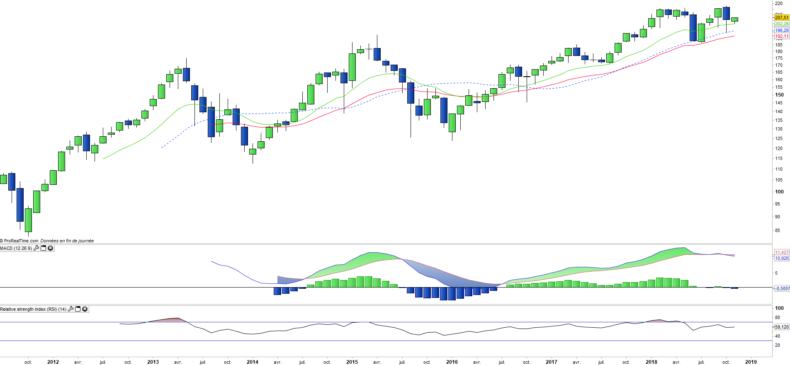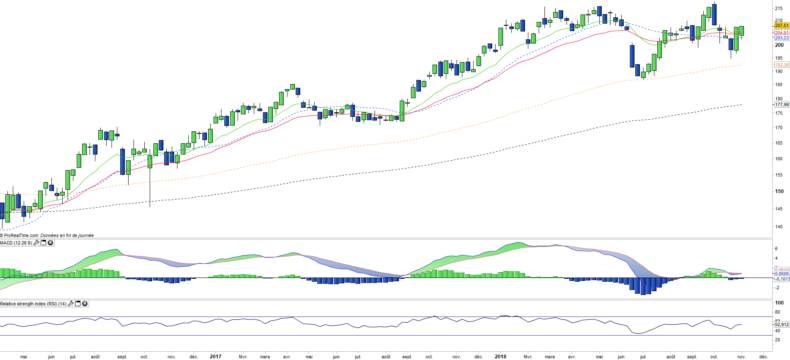Lyxor Thailand UCITS (THA) - 09/11/2018
Short Term strategy: Positive (70%) / Trend +
Long Term strategy: Positive (85%) / Trend =
Characteristics of the ETF
The THA ETF (Lyxor UCITS) created in 07/2011 and which is listed in Euro on Euronext replicates the SET 50 Net Total Return index, denominated in Thai Baht (THB). The SET 50 Index is the benchmark of the Thai Stock Exchange consisting of the top 50 values in terms of float and liquidity-adjusted market capitalization.
ETF fees are 0.45% while AUM amount to € 18m. The replication method is indirect (via a swap) and there is a dividend capitalization policy.
Alternative ETFs: THD (iShares in USD)
Latest developments
The performance of THA in 2017 was + 16.5%, after an increase of + 27.1% in 2016, which reflects an economic growth of GDP of around 3.6% in 2017.
In 2018 the index is up by 5%, which is in line with the S & P500.
The Thai economy has benefited from the good momentum registered on oil and cotton prices since the beginning of the year.
The International Monetary Fund (IMF) has raised Thailand's economic growth forecast for 2018 to 4.6 % from 3.9 % last year, while reducing economic growth forecasts for the ASEAN countries due to the trade war between the USA and China. The IMF also expects the Thai economy to grow only 3.9% in 2019 for the same reasons.
Thailand, on the other hand, could benefit from a breakthrough in negotiations between the US and China, which are scheduled to meet at the end of November in the G20 for negotiations on a potential trade agreement.
Index & components
THA replicates a rather deep index but of which almost 2/3 of the capitalization depends on 4 sectors: energy (22%), financials (18%) followed by industry (12%) and basic materials (11%).
The top 10 stocks, where there are many industrial stocks and some banks account for almost half (48%) of the index's capitalization.
This tracker naturally embeds the risk related to the baht, more volatile than the reference currencies.
Thailand is the second largest economy in Southeast Asia (after Indonesia), with a GDP of nearly $ 400 billion for 68 million people - a population comparable to France -. Despite the many shocks collected (political crises, economic, natural disasters) the Thai economy is showing great resilience. Growth increased by around 3.2% in 2016. Thailand is an emerging economy, which is highly dependent on exports, accounting for more than two-thirds of GDP. Thailand, an active member of ASEAN is very open to international trade, its main customers are the United States, China and Japan. Mainly exported goods are electrical and electronic products, machinery, vehicles, rubber and plastics. Its main suppliers are China, Japan, the United States, Malaysia and the United Arab Emirates.
The Thai economy is heavily based on agriculture, which contributes about 11% of GDP and employs more than 40% of the labor force. The country is one of the main producers and exporters of rice, the other crops being rubber, sugar, maize, jute, cotton and tobacco. Fishing is also an important activity, with Thailand being a major exporter of farmed shrimp. The manufacturing sector accounts for just over 37% of GDP and is well diversified. The main Thai industries are the electronics, steel and automotive industries. Thailand is an assembly center of international car brands. Electrical appliances and components, computers, cement production, furniture and plastic products are also important sectors. The tertiary sector, including tourism and financial services, contributes over 53% of GDP and employs almost 40% of the population.
After nearly three consecutive years of decline, Thailand's exports have returned to positive growth in 2016, which was confirmed in 2017. The factors contributing to Thailand's export growth are rising world prices. fuels and the devaluation of the Thai baht which now stands around 32.5 baht per US dollar. However, measures taken by the US administration could result in trade restrictions on goods from China and Mexico and indirectly affect Thailand, with China being one of the country's major trading partners.
Monthly data
The monthly trend remains positive, with October's correction much less pronounced than in February and showing excellent relative resistance against other world markets. The oscillators remain in the high zone and the moving averages keep rising. The November candlestick is a rebound that is likely to register new highs soon. The Thai index has an attractive long-term configuration.
Weekly data
The weekly chart shows the end of the bearish attack that was contained well before the EMA100 level that halted the February / March correction. The prices are already ironed over the EMA13 and 26 and are moving quickly towards the peak of the year. The medium-term trend is positive and is reinforced by the weak bearish attack of October which failed to reach the lows of the year. The technical oscillators confirm the current rebound phase.
ETF Objective
THA is a UCITS ETF, listed in €, which seeks to replicate the SET 50 Net Return thailand index (50 companies)
Characteristics
| Inception date | 04/07/2011 |
| Expense ratio | 0,45% |
| Issuer | Lyxor |
| Benchmark | SET 50 Net Total Return |
| Ticker / code | THA |
| ISIN | FR0011067529 |
| UCITS | Yes |
| Currency | € |
| Exchange | Euronext Paris |
| Assets Under Management | 18 M€ |
| Replication method | indirect (swap) |
| Dividend | Capitalisation |
| PEA (France) | No |
| SRD (France) | Yes |
| Currency risk | Yes |
| Number of Holdings | 50 |
| Risk | 4/5 |
Country breakdown
| Thailand | 100% |
Sector Breakdown
| Energy | 22% |
| Financials | 19% |
| Industrials | 12% |
| Materials | 11% |
| Consumer staples | 9% |
| Communication Services | 9% |
| Consumer discretionary | 5% |
| Others | 14% |
Top Ten Holdings
| PTT | 12% |
| Airports of Thailand | 8% |
| CP All | 5% |
| Siam Cement Public | 5% |
| Advanced Info Service | 5% |
| PTT Explor&Prod Public | 5% |
| Kasikornbank | 4% |
| Siam Commercial Bank | 4% |
| Bangkok Bank Public | 4% |
| Bangkok Dusit Med Service | 3% |


